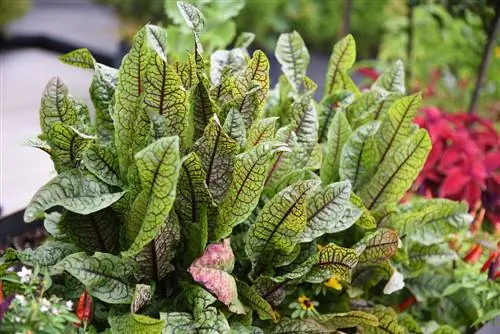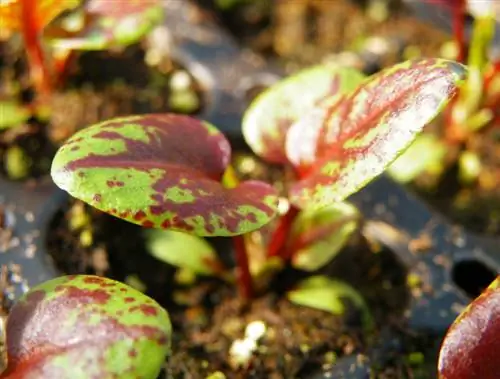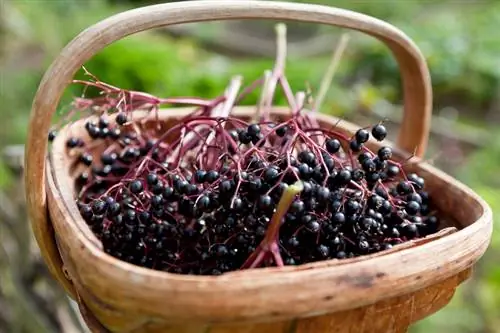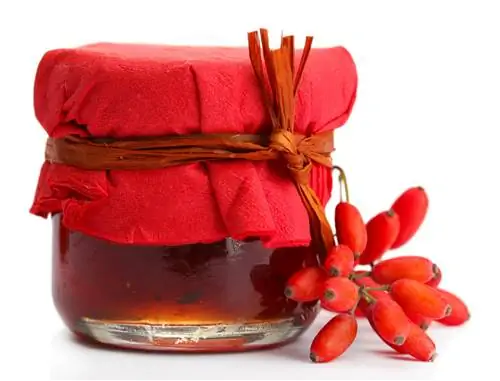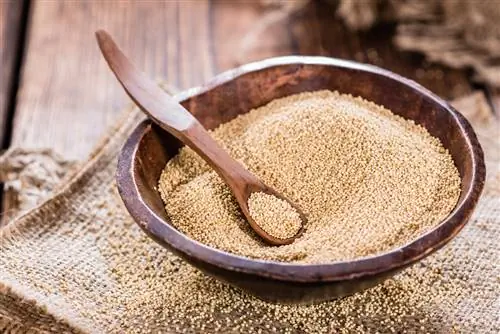- Author admin [email protected].
- Public 2024-01-10 23:11.
- Last modified 2025-06-01 06:02.
A natural plant arrangement is a trend in hobby gardens. A native herb plant meets this wish perfectly. Blood dock impresses as a lush, herbaceous perennial with purple-tinged leaves and reddish flowers. The leaves can be processed into tasty vegetables. Healers use the ingredients to relieve minor ailments. Read here how easy it is to cultivate the plant.

What is blood dock and how do I cultivate it in the garden?
The blood dock is an herbaceous perennial with purple leaves and flowers that is used as a vegetable or medicinal plant. The plant prefers partially shaded locations, nutrient-rich, humus-rich and moist soils. It can be easily propagated by sowing or dividing.
Planting blood sorrel correctly
Instead of straining your gardening budget by buying early young plants, simply sow purple docks directly into the bed. The best time for this measure is September. If you miss this date, plant the herb plant in the garden between March and June. In a partially shaded location, prepare the moist, humus-rich soil in a finely crumbly manner. Make a furrow to plant the seeds 5 to 10 mm deep and press the soil down a little. Moisten with a fine spray and wait for germination. To protect against pecking birds, spread a close-meshed net over the seedbed. Once at least 2 pairs of leaves have developed on the seedlings, the strongest specimens are separated at a distance of 20-30 cm.
Care tips
If the blood dock finds a partially shaded, freshly moist location in normal garden soil, the care required is hardly significant. How to do it right:
- Water regularly without causing waterlogging
- Starting fertilization with compost and horn shavings covers the nutrient requirements
- Cut off the outer leaves for consumption
- Consistent flowering keeps the oxalate content in check
Hain-Schampfer doesn't have to worry about winter protection. Leave the leaves on the plant until early spring and prune them before new shoots appear.read more
Which location is suitable?
In order to enjoy the full range of its advantages, the location should be selected according to these criteria:
- Partly shady location up to light shade
- The sunnier the location, the wetter the soil
- Nutritional, humic and with a low lime content
Red dock preferably joins the classics in the herb bed, takes place in the open field with wild perennial character, along the edge of the wood or on the banks of a water world.
What soil does the plant need?
Red dock does its best in nutrient-rich, humus-rich and fresh, moist soil. As long as a minimum level of permeability is guaranteed, the perennial can even tolerate short-term flooding. A grove dock is therefore ideal for greening ponds and streams. However, avoid a place in soil with a strongly alkaline structure, because the herb plant reacts to an excess of lime with leaf chlorosis.
What is the best time to plant?
Gardening practice has shown that autumn planting or sowing is particularly beneficial for purple docks. In addition to optimized vitality, the plant benefits from an improved taste of the leaves. These make even gourmets take notice in spring with their delicate, mild aroma.
Cutting blood sorrel correctly
Cutting and harvesting go hand in hand with a blood dock. In spring - shortly before flowering - the plant is at the peak of its enjoyment potential. Now cut off the outer leaves to use in the kitchen or for making tea. Break out inflorescences consistently. As these develop, the oxalic acid content increases and the plant loses value. Leave the leaves in the bed throughout the winter as a natural protection. In early spring, cut off all leaves close to the ground so that the shoots can sprout unhindered.
Water blood sorrel
Do not let blood dock dry out at any time, as the herb plant will react angrily. Water regularly and generously without causing waterlogging. Ideally, you should use soft water so that no limescale builds up in the substrate.
Fertilize blood sorrel correctly
In nutrient-rich garden soil, initial fertilization with compost and horn shavings is sufficient. If the growth of blood dock does not meet expectations, add a liquid, organic vegetable fertilizer (€19.00 at Amazon) to the irrigation water every 3-4 weeks over the course of the season. If the leaves are intended for consumption, the use of nettle manure as fertilizer is less of an option as the taste could adversely change.
Wintering
The perennial is completely winter-proof and does not require any special precautions. Ideally, you should only cut the leaves close to the ground in early spring so that they protect the root ball from cold and moisture until then.
Propagate blood sorrel
In order to propagate blood docks, the majority of hobby gardeners decide to divide the root ball. The advantage of this method is that the perennial is rejuvenated at the same time, which is necessary every few years anyway. Dig up the root ball, cut it into two or more segments and place them in the ground at the new location. A section should have at least two eyes from which it can sprout again.
Alternatively, sow the seeds directly into the bed. Between March and June or ideally in September, prepare a permeable, slightly moist, sandy, humus-rich seedbed for the seeds. As a dark germinator, plant the seeds 5-10 mm deep in a small furrow. Keep the soil constantly moist and do not apply fertilizer. As the process progresses, the seedlings are separated with 2 pairs of leaves at a distance of 20-30 cm.
How do I transplant correctly?
The vitality of a grove dock visibly decreases after 5 years at the latest. It's high time for a change of location. To do this, dig up the perennial and divide the root ball into two halves. Cut off any old and bare pieces in order to plant the rejuvenated segments in the new place. If you enrich the soil with compost and horn shavings in advance, the rooting will progress quickly.
How to use blood dock?
Red sorrel trumps the related sorrel with its milder taste. For this reason alone, the knotweed plant is enjoying increasing popularity. In addition, the herbal plant has been used in folk medicine for generations. We have compiled the most common uses for you here:
- For preparing as a spinach-like vegetable
- For refining soups, sauces and salads
- As a tea to relieve dry coughs, stomach and intestinal problems, loss of appetite and other ailments
It should be noted that the proportion of oxalic acid is quite high. Excessive consumption can cause kidney damage in sensitive people and young children. However, consumption in small quantities is harmless. Anyone who suffers from iron deficiency should refrain from consuming it entirely.read more

